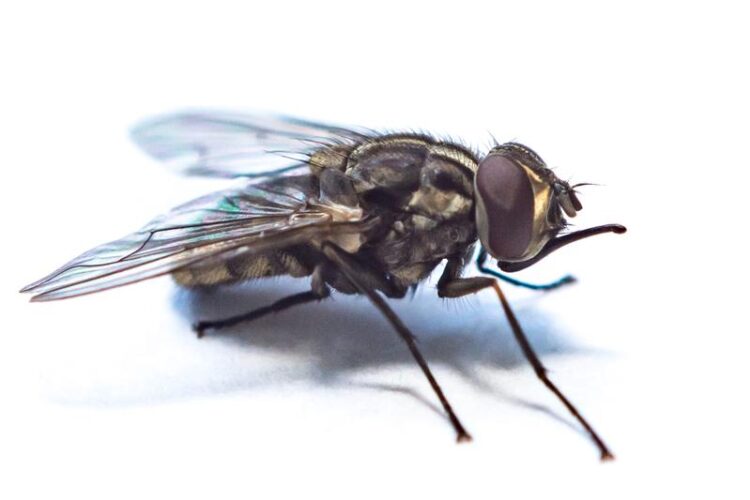The stable fly: a potentially dangerous carrier of disease for pigs

Stable fly
Michael Bernkopf/Vetmeduni Vienna
The stable fly (Stomoxys calcitrans) is abundantly found worldwide and resembles the common housefly. The biggest difference is that the stable fly has a bayonet-like proboscis for blood sucking. While feeding, these flies can transmit diseases to the host animals, including humans. A Vetmeduni Vienna study has now investigated the extent to which pigs are at risk of disease transmitted by the stable fly.
The stable fly is frequently found in animal farms. The blood-sucking insect is anything but harmless, as it has direct and indirect influences on animal health. Direct influences can include restlessness, pain due to biting, stress, loss of blood, reduced feed intake and lesions of the skin followed by local inflammation and immunosuppression, while indirect effects are due to the transmission of infectious agents. For other host species, such as horses, stable flies are known to be relevant vectors for the transmission of infectious diseases. To date, however, few studies exist involving pigs.
Vector for numerous microorganisms
To learn more about the possible role of stable flies in the transmission of infectious agents, a research team led by Lukas Schwarz from the University Clinic for Swine at Vetmeduni Vienna, as part of a diploma thesis, examined stable flies from Austrian pig farms for the presence of swine pathogens such as PRRSV (a viral disease in pigs associated with respiratory problems and reproductive disorders), PCV2 (a viral porcine disease that can be accompanied by wasting, difficulty in breathing, reproductive disorders and diarrhoea), haemotrophic mycoplasmas (bacteria that attack the red blood cells) and cultivable bacterial pathogens. In their pilot study, the researchers also investigated the use of stable flies as a diagnostic matrix to detect pathogens in the ingested pig blood.
“In total, we found 69 different microorganisms on the surface of tested S. calcitrans from 20 different pig farms. Escherichia coli was the most common bacterium and could be found on flies from seven farms. Also at seven farms, haemotrophic mycoplasmas were detected in stable flies. PRRSV could not be found in any of the samples, but PCV2 was detected in six farms,” says study director Lukas Schwarz. Financial support for this study was provided by the Verein der Freunde und Förderer der Schweinemedizin.
Underestimated carriers of disease
The results of the study suggest that stable flies in Austrian pig farms are carriers of several different bacterial species and may also serve as vectors for PCV2 and haemotrophic mycoplasma. Schwarz stresses that more attention should therefore be paid to stable flies and their role as a disease vector in pigs: “Although we cannot evaluate the explicit role of S. calcitrans as a vector, we think that the role of stable flies in disease and pathogen transmission among pigs in Austria is underestimated.”
Potential new diagnostic method
The researchers also suggest using stable flies as a diagnostic matrix for the detection of PCV2 and haemotrophic mycoplasmas. Schwarz points out, however, that future studies are needed to confirm this possibility and to clarify whether stable flies may also be used as a diagnostic matrix for the detection of PRRSV. Furthermore, using stable flies for herd health surveillance would be a cost-effective and humane alternative to blood sampling or other invasive sampling techniques in pigs.
Unpleasant guest in many farms
The stable fly S. calcitrans is one of 18 species belonging to the genus Stomoxys and is most common in the temperate climate zones. The 7 to 8 mm long fly is grey and has four dark longitudinal stripes on the thorax. In contrast to the common housefly (Musca domestica) – the dominant fly species on swine farms – the stable fly has a shorter and wider abdomen. S. calcitrans also has three dark spots on each of the second and third abdominal segments and its wings protrude from the body. Both the smaller male and the larger female are bloodsuckers with piercing mouthparts for sucking blood. The stable fly prefers damp straw, dung and old litter for breeding and does not lay its eggs in pure faeces. Stable flies are often found in the stables of ruminants and horses, but also in swine farms, and their bites can cause considerable economic losses in livestock farming.
Wissenschaftliche Ansprechpartner:
Lukas Schwarz
University Clinic for Swine
University of Veterinary Medicine Vienna (Vetmeduni Vienna)
T +43 1 25077-5228/-6848
Lukas.Schwarz@vetmeduni.ac.at
Originalpublikation:
The article „The Stable Fly (Stomoxys calcitrans) as a Possible Vector Transmitting Pathogens in Austrian Pig Farms“ by Lukas Schwarz, Andreas Strauss, Igor Loncaric, Joachim Spergser, Angelika Auer, Till Rümenapf and Andrea Ladinig was published in microorganisms. https://www.mdpi.com/2076-2607/8/10/1476
Weitere Informationen:
https://www.vetmeduni.ac.at/en/infoservice/press-releases/press-releases-2020/th…
Media Contact
All latest news from the category: Agricultural and Forestry Science
Newest articles

A universal framework for spatial biology
SpatialData is a freely accessible tool to unify and integrate data from different omics technologies accounting for spatial information, which can provide holistic insights into health and disease. Biological processes…

How complex biological processes arise
A $20 million grant from the U.S. National Science Foundation (NSF) will support the establishment and operation of the National Synthesis Center for Emergence in the Molecular and Cellular Sciences (NCEMS) at…

Airborne single-photon lidar system achieves high-resolution 3D imaging
Compact, low-power system opens doors for photon-efficient drone and satellite-based environmental monitoring and mapping. Researchers have developed a compact and lightweight single-photon airborne lidar system that can acquire high-resolution 3D…





















